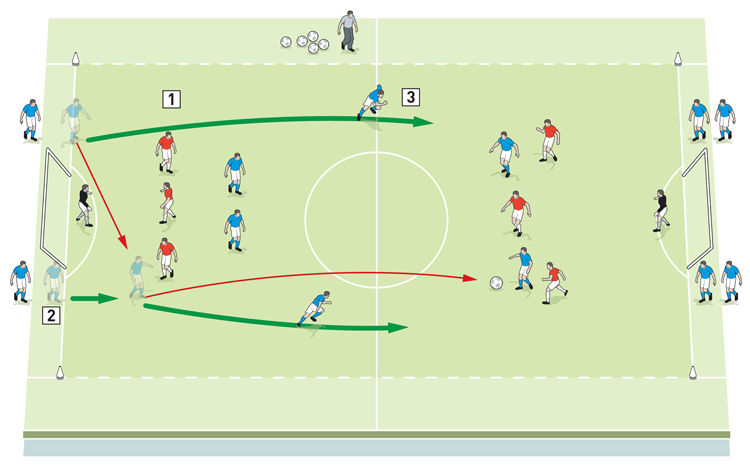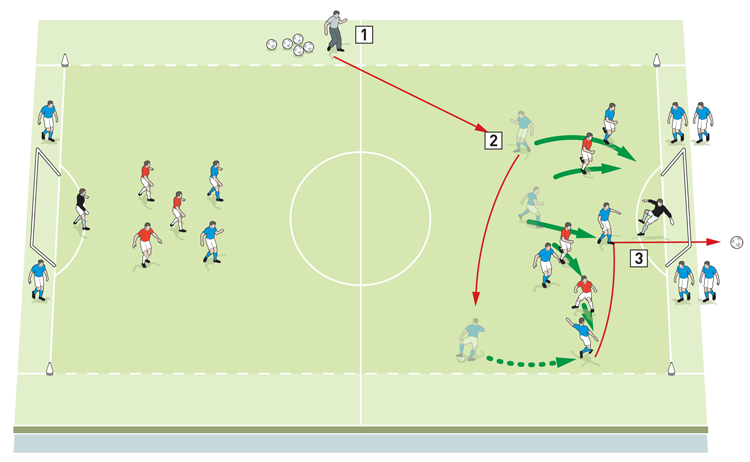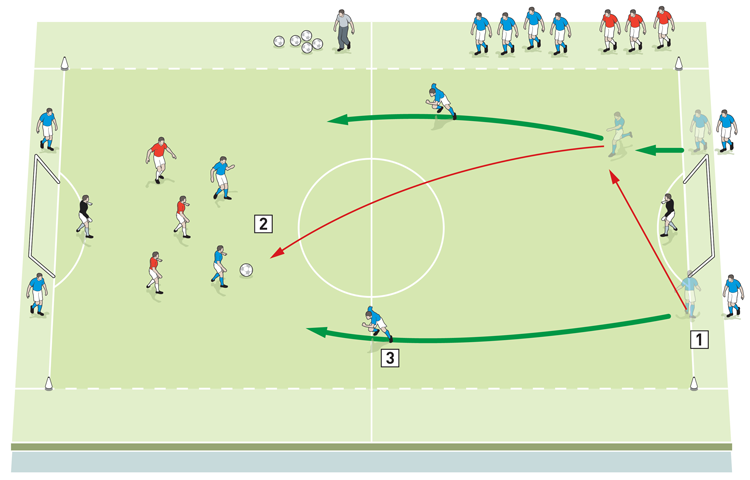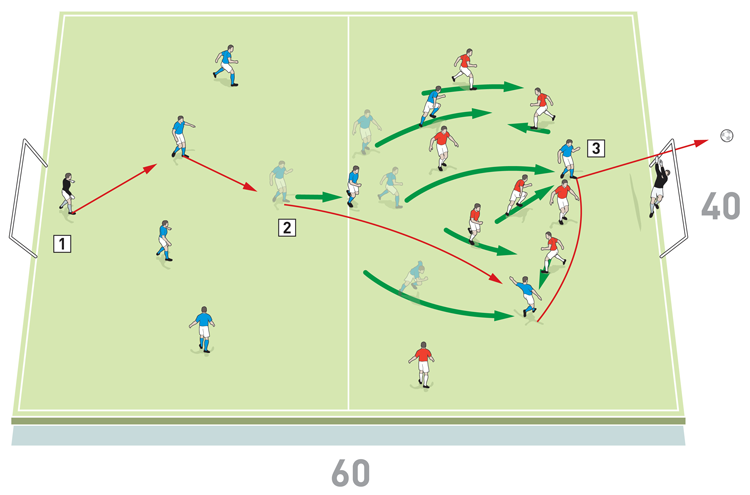




OUR BEST EVER OFFER - SAVE £100/$100
JOIN THE WORLD'S LEADING PROFESSIONAL DEVELOPMENT PROGRAMME
- 12 months membership of Elite Soccer
- Print copy of Elite Player & Coach Development
- Print copy of The Training Ground
You are viewing 1 of your 1 free articles
High speed counter-attacks
The counter-attack is an integral element of the modern game and teams can utilise this tactic to their advantage. This session specifically encourages attackers to make key penetrating movements that are all very realistic to a game situation.
| Area | Up to two thirds of pitch |
| Equipment | Balls, bibs, cones, 2 full size goals |
| No. of Players | Up to 18 players + 2 goalkeepers |
| Session Time | Attack v defence: 30mins Small-sided game: 30mins |
The session is about counter-attacking. It specifically encourages attackers to make key penetrating movements that are all very realistic to a game situation.
The counter-attack is an integral element of the modern game and teams can utilise this tactic to their advantage. In the Premier League, the average counter-attack lasts 14.7 seconds, however for a counter-attack ending in a shot, the average is 16.7 seconds.
In this session, giving the players eight seconds to score works well for us. This makes the session realistic to the game as a good amount of goals are now scored on the break against a defence that is out of shape. However, if needed the time restrictions can be adapted to meet the demands of the level played at.
In this session, the players particularly enjoy being given some freedom in terms of their attacking combinations.
Typically, we will run this practice on a Tuesday (MD-4). Most players will see this as just an attacking session, however the defenders are equally important because we need to be clinical both when attacking and defending.
What do I get the players to do?
Attack v defence
We set up between the penalty boxes with a goal and a keeper at each end. The playing area is coned off to the width of the penalty area. We’re using 18 outfield players, split into six defenders (the reds) and 12 attackers (the blues). Three defenders and two attackers start in each half. The remaining eight attackers wait in pairs on either side of both goals.
Play begins with the attackers beside one of the goals. Two of them enter the playing area and combine before passing to their team mates in the other half and making runs to follow the ball, as shown [1a]. This creates a 4v3 overload in the attackers’ favour, but they must move quickly as teams only have eight seconds to score.
1a

2. The attackers either side of goal start play by combining. They then pass into the other half. From the starting pass, their team has just eight seconds to score
3. Both starting attackers quickly follow the ball into the other half, giving their team a 4v3 advantage as they try to score
Once the eight seconds are up or the ball has gone dead in the first attack, the coach then serves a random pass into an attacker, who receives the ball on the half turn. The player then combines with his team mates to attack the same goal as before, as shown [1b]. This phase is intended to represent a counter-attack failing but the ball being recovered by a team mate, who launches a second counter-attack.
1b

2. The attacker receives the ball on the half turn before passing to a team mate
3. The attackers should use the spare man to their advantage and set up a scoring opportunity
After the second attack is dead, repeat the practice in the opposite direction, as shown [1c].
1c

2. Here the striker holds up the ball while waiting for support from team mates
3. The two starting players quickly join the striker in the other half to make it a 4v3 attack. The blues have just eight seconds to score
How do I progress the activity?
We can limit the amount of touches a player makes on the ball or change the time constraints. We can also add or remove players from either of the teams. The starting positions of the defenders are also adaptable and we can start them deeper to encourage early crosses.
To give the keepers involvement in the attacking phase, they could play the ball directly to the forwards.
What are the key things to look out for?
Technically there are a lot of elements that will be tested by this activity. We want to see attackers using positive and progressive play to maintain a good tempo in the attacking waves. We also want to see players getting their shots off quickly and clinically but without resorting to forcing play when the shot isn’t on.
We encourage attackers to make the pitch big, using the spare man to their advantage. We also ask players to use different types of delivery, such as crosses, cut backs and through balls.
In the second wave, we want to see the attacker using a good first touch when receiving from coach.
Tactically the areas that the players run into are vital, as two attacking players cannot be mirroring each other’s runs. Positive overlaps are also encouraged.
This drill is demanding and requires a good level of physical output. Also, working under the pressure of a time constraint will benefit the mentality of the players. Being able to work quickly and under pressure are all key to the modern game, so we test this to the maximum in our training sessions.
What are the typical mistakes that players might make, and how do I avoid them?
The practice won’t go smoothly if we have a striker who holds on to the ball for too long or doesn’t hold it up enough. We must also ensure that the attackers do not keep repeating the same runs and combinations, as this will make them too predicable.
Problems also arise if the midfield players don’t play the ball to the attackers early enough, or if the wide man fails to take on the defender in a 1v1 because he’s not positive or aggressive enough.
Players need to ensure that the activity is match-realistic and played at pace – it won’t work if the players are operating at half pace.
How would you put this into a game situation?
Small-sided game
Next we play a small-sided game. The area size can be adapted to suit the numbers, but here we are playing 9v9 including goalkeepers, in an area of 60x40 yards, as shown [2]. Condition the game so that once the ball passes into the opposition half, there is only six seconds to score.
2

2. Once the ball goes into the opposition half, the attacking team has only six seconds to score
3. To progress the game we can restrict the attackers to using a one-touch finish
How do I progress the game?
To progress the game we can restrict attackers to using a one-touch finish. We will also condition the defending team to make a minimum of four passes after winning the ball back from their opponents and we encourage them to play forwards when possible.
What are the key things to look out for in the game?
Make sure that the attacking team incorporates all of the coaching points from the initial practice.
We also want to see the wide player on the opposite side to the attack getting into the box for a cutback, or to meet a cross.
Players should look sharp in front of goal and capitalise on any rebounds.
Related Files
Editor's Picks
Attacking transitions
Deep runs in the final third
Using the goalkeeper in build-up play
Intensive boxes drill with goals
Penetrating the final third
Creating and finishing
My philosophy
Pressing initiation
Compact team movement
Coaches' Testimonials

Alan Pardew

Arsène Wenger

Brendan Rodgers

Carlos Carvalhal

José Mourinho

Jürgen Klopp

Pep Guardiola

Roy Hodgson

Sir Alex Ferguson

Steven Gerrard
Coaches' Testimonials

Gerald Kearney, Downtown Las Vegas Soccer Club

Paul Butler, Florida, USA

Rick Shields, Springboro, USA

Tony Green, Pierrefonds Titans, Quebec, Canada
Join the world's leading coaches and managers and discover for yourself one of the best kept secrets in coaching. No other training tool on the planet is written or read by the calibre of names you’ll find in Elite Soccer.
In a recent survey 92% of subscribers said Elite Soccer makes them more confident, 89% said it makes them a more effective coach and 91% said it makes them more inspired.
Get Monthly Inspiration
All the latest techniques and approaches
Since 2010 Elite Soccer has given subscribers exclusive insight into the training ground practices of the world’s best coaches. Published in partnership with the League Managers Association we have unparalleled access to the leading lights in the English leagues, as well as a host of international managers.
Elite Soccer exclusively features sessions written by the coaches themselves. There are no observed sessions and no sessions “in the style of”, just first-hand advice delivered direct to you from the coach.







